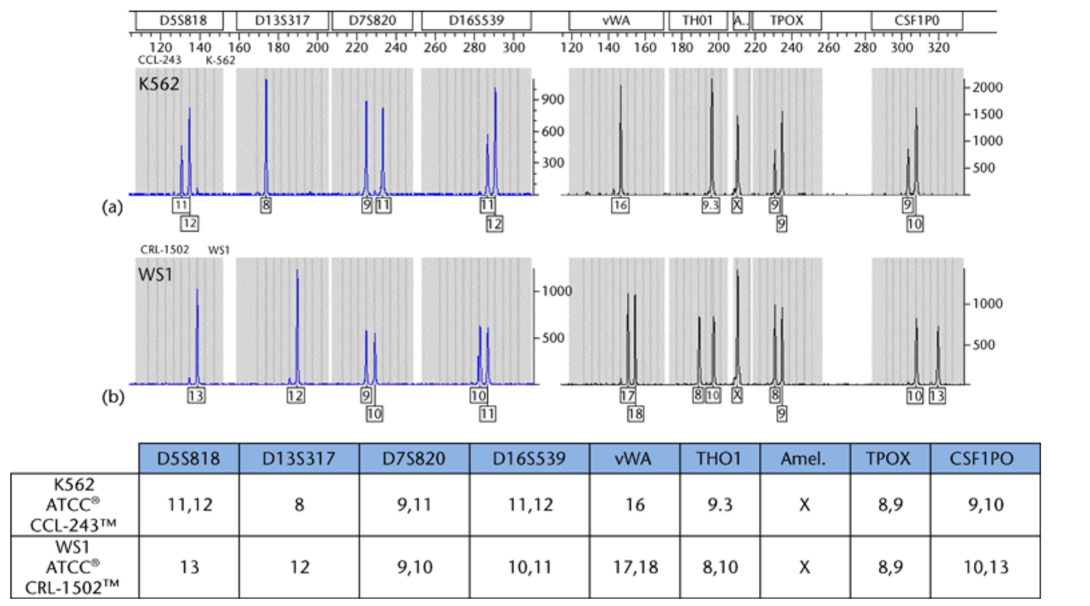STR Profiling—The ID Card of Cell Line
Background Information
 Continuous cell lines have been used extensively as models for biomedical research more than 50 years. With a rapid growth in the use of cells in different areas, the potential risk of cross-contamination of cell cultures increased progressively. Cross-contamination among cultured cell lines and cell line misidentification are the persistent problems and has occurred at frequencies ranging from 16 to 35%. HeLa was the first tumor cell line derived from an invasive cervical carcinoma in 1951. At one time, Hela was shown to contaminate more than one-third of all human tumor cell lines developed for research in cancer and cell biology which resulted in more than 30,000 scientific articles online that reported on the wrong cells. In addition to Hela, Drexler et al. found that 15% of 117 hematopoietic cell lines received from original investigators or a secondary source was cross-contaminated with other cell lines. And more recent reports have shown cross-contaminated cell lines from breast and prostate cancers, thyroid cancer, adenoid cystic carcinoma, and esophagus.
Continuous cell lines have been used extensively as models for biomedical research more than 50 years. With a rapid growth in the use of cells in different areas, the potential risk of cross-contamination of cell cultures increased progressively. Cross-contamination among cultured cell lines and cell line misidentification are the persistent problems and has occurred at frequencies ranging from 16 to 35%. HeLa was the first tumor cell line derived from an invasive cervical carcinoma in 1951. At one time, Hela was shown to contaminate more than one-third of all human tumor cell lines developed for research in cancer and cell biology which resulted in more than 30,000 scientific articles online that reported on the wrong cells. In addition to Hela, Drexler et al. found that 15% of 117 hematopoietic cell lines received from original investigators or a secondary source was cross-contaminated with other cell lines. And more recent reports have shown cross-contaminated cell lines from breast and prostate cancers, thyroid cancer, adenoid cystic carcinoma, and esophagus.
So can you guarantee the cell line you have is the real one?
STR Profiling for Cell Authentication
A Short Tandem Repeat (STR) analysis is one of the most useful methods in molecular biology. Previously, it is just used as an extremely valuable tool for human DNA identification. The same principle can be used to identify cell line: comparing specific loci on DNA from present or original samples to investigate whether the cell line we used is right or not.
Short tandem repeats (STRs) are repeated segments of DNA that are typically 2-6 base pairs in length, as a microsatellite, consisting of a unit of two to thirteen nucleotides repeated hundreds of times in a row on the DNA strand. Using STR analysis can measure the exact number of repeating units which is the key to authenticate different types of cell lines.
 Figure 1. Electropherograms of STR DNA profiles of two unrelated cell lines: (a) K562 (chronic myelogenous leukaemia) and (b) WS1 (skin fibroblast). Cells spotted onto an FTA® card were amplified by multiplex PCR, separated by capillary electrophoresis, and analysed by Genotyper® software. The peaks at each locus were converted to numerical values based on allelic ladders. The numerical values or the unique STR profile of each cell line can be used to establish a database. (Masters)
Figure 1. Electropherograms of STR DNA profiles of two unrelated cell lines: (a) K562 (chronic myelogenous leukaemia) and (b) WS1 (skin fibroblast). Cells spotted onto an FTA® card were amplified by multiplex PCR, separated by capillary electrophoresis, and analysed by Genotyper® software. The peaks at each locus were converted to numerical values based on allelic ladders. The numerical values or the unique STR profile of each cell line can be used to establish a database. (Masters)
The Difference Between STR Profiling and RFLP Analysis
Scientists ever tried to use restriction fragment length polymorphism analysis (RFLP) to identify cell line, but the efficiency and accuracy rate were both low. Instead, STR analysis directly attached the probes to desired regions on the DNA, and a polymerase chain reaction (PCR) is employed to discover the lengths of the short tandem repeats which greatly increased reliability and veracity of the results.
Advantages of STR Profiling
- Relatively inexpensive
- Quick turnaround time
- Commercial availability of amplification kits
- Highly sensitive
- High abundance of detection range
- Recognized by many organizations and scientists

The Application of STR Profiling
In addition to use for cell authentication and paternity test, STR analysis can also be used in the following area:
- Tracking and Confirming Tissue Provenance and Detecting Contamination
STR analysis provides a fast and easy way to compare the sample tissue with the reference tissue to determine the sample’s identity. Likewise, STR analysis can be used to detect sample contamination, which allows detection of minute quantities of contaminated cells or tissue.
- Detecting Maternal Cell Contamination and Fetal Aneuploidy
STR analysis can help ensure that a prenatal fetal sample is not contaminated with maternal cells, meanwhile, it can detect fetal chromosomal abnormalities, such as trisomies and other aneuploidies.
- Cancer Research
Cancer researchers can track determine genetic changes by examining STR loci to detect DNA duplications, deletions or other mutations and use this information identify key chromosomal regions that are altered during pathogenesis.
When You Need STR Analysis?
In early 2011, ATCC has set an STR profiling standard (ANSI/ATCC ASN-0002-2011) of human cell lines in order to restrain the invalid scientific data increased by cross-contamination and error identification of cell lines. More importantly, accurate cell line identification plays a crucial role in the new medical products development based on cells, it can avoid human exposure to the risk of error identification cells. Meanwhile, more and more journals require submitting the cell line authentication first before the submission of research findings, as well as the list of journals which need guidelines for cell line authentication prior to publication is attached at the end.
- Before a new research finding is submitting, or when applying for a new project.
- When recovery cells that have frozen storage for many years.
- When a new cell line is acquired, and when preparing a new cell bank for storage.
- An established cell line which have grown continuously for more than 10 passages.
- When the performance of cell line is unstable or the result is different from expected.
- When conducting the chimerism examination after allogeneic cell transplantation.
STR Profiling at Creative Bioarray
Increasingly, researchers are turning to STR analysis to verify the origin of biological samples, detect sample contamination and track genetic changes. The sensitivity and high power of discrimination make STR analysis an ideal choice for the types of applications discussed here.
Creative Bioarray, as a leading biotech company which specialized in cell biology, provides professional STR profiling to help authenticate cell lines. Our high-quality services are dedicated to accelerating the procedure of your research. Looking forward to cooperating with you.
*The list of journals which need guidelines for cell line authentication prior to publication
- Nature;
- BioTechniques;
- Cancer Research;
- Cancer Discovery;
- Clinical Cancer Research;
- Molecular Cancer Research;
- Cancer Prevention Research;
- International Journal of Cancer;
- Molecular Cancer Therapeutics;
- Cell Biochemistry and Biophysics;
- Cancer Epidemiology, Biomarkers & Prevention;
- In Vitro Cellular & Developmental Biology – Animal;
...
References:
- Masters, John R., and Yvonne A. Reid. "Cell Line Authentication and Characterisation." eLS.
- Boonstra, J.J.; et al. Mistaken identity of widely used esophageal adenocarcinoma cell line TE-7. Cancer Res. 2007,67, 7996–8001.
- Barallon, R.; et al. Recommendation of short tandem repeat profiling for authenticating human cell lines, stem cells, and tissues. In Vitro Cell Dev. Biol. Anim. 2010, 46, 727–32.
- Turajlic, S.; et al. Whole genome sequencing of matched primary and metastatic acral melanomas. Genome Res. 2012, 22, 196–207.